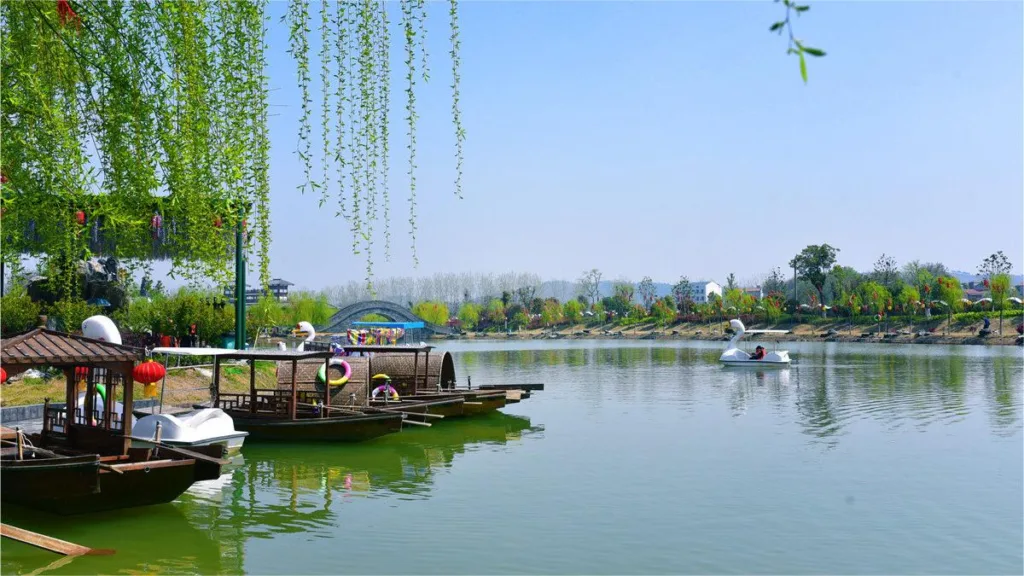Wuhan is constantly moving rapidly towards the future, sometimes making people wonder whether the past of blue bricks, red walls, and alleys still exists. In fact, like plants and humans, cities have roots and souls, and development is like a time machine that allows you to explore the past when you want to. Wuhan boasts small mountain ranges, scattered lakes in the three towns, ancient and renowned academies, and delicious food in its alleys.
Day 1: Huanghe Tower > Hubu Alley > Gude Temple > Jianghan Road Pedestrian Street > Baocheng Road Night Market
First Stop: Yellow Crane Tower (2 hours)
Yellow Crane Tower, located atop the summit of Snake Hill on the south bank of the Yangtze River, is one of Wuhan’s urban landmarks. It used to be a military fortress and is now a famous scenic spot. From atop Yellow Crane Tower, you can overlook the landscapes of the three towns of Wuhan and the majestic Yangtze River.
Second Stop: Hubu Alley (1 hour)
From Yellow Tower to Hubu Alley, it’s about a 15-minute walk. Hubu Alley is a street full of Han-style flavors, with hundreds of small eateries and thousands of specialty foods. Although the street is only 150 meters long, it guarantees to satisfy your appetite with various delicacies such as hot dry noodles, tofu skin, duck neck, and stinky tofu.
Third Stop: Gude Temple (1.5 hours)
About a 10-minute walk to the Zhonghua Road Wharf, take a ferry to the other side of the Yangtze River. For only 1.5 yuan per person, you can enjoy the daytime scenery of the Yangtze River. Then, take a bus from the Wuchang-Wuhan Guan Station to the next stop, Gude Temple. Although it is a Han Buddhist temple, the architecture blends Indian, Burmese, and European styles, making it unique.
Fourth Stop: Jianghan Road Pedestrian Street (2 hours)
From Gude Temple to Jianghan Road Pedestrian Street, it’s about a 40-minute subway ride. Jianghan Road Pedestrian Street used to be the British concession in Hankou and features many modern old buildings such as the Qing Dynasty Bank Building, China Industry Bank, and Simei Bank. It is also a century-old commercial street in Wuhan, where you can find many fashionable brands, Hankow Customs Museum, department stores, and local snacks.
Fifth Stop: Baocheng Road Night Market (1 hour)
It’s less than a 10-minute walk from Jianghan Road Pedestrian Street to Baocheng Road Night Market. When night falls, the market gradually becomes lively, offering various daily necessities and small trinkets. It’s a great place for photography with its colorful neon lights flashing between buildings. Nearby is a “Single Hole Flower Market” where you can find many beautiful and cheap flowers if you’re interested.
Day 2: Hubei Provincial Museum > Chu River and Han Street > Tanhualin > Hankou Riverbank
First Stop: Hubei Provincial Museum (3 hours)
In the morning, visit the Hubei Provincial Museum to see precious cultural relics such as the Zenghouyi Chime Bells, King Goujian’s Sword, Yuxian Human Skull Fossils, and Siai Plum Bottle. The museum consists of three ancient-style buildings, reflecting the architectural layout of ancient Chu State.
Second Stop: Chu River and Han Street (2 hours)
From Hubei Provincial Museum to Chu River and Han Street, it takes about 30 minutes by subway. Chu River and Han Street is a street with ancient Chinese style, bustling with many restaurants, clothing stores, Madame Tussauds Wax Museum, and Han Street Wen Hua Bookstore. It’s a one-stop destination for eating, drinking, and entertainment.
Third Stop: Tanhualin (2 hours)
From Chu River and Han Street to Tanhualin, it takes about 30 minutes by subway. Tanhualin is currently Wuhan’s top literary and artistic street, condensed with the cultural nostalgia of the entire city. Take a leisurely walk, take photos, send postcards to friends, and enjoy an afternoon with the aroma of coffee.
Fourth Stop: Hankou Riverbank (2 hours)
From Tanhualin to Hankou Riverbank, it takes about 40 minutes by subway. The Hankou Riverbank has witnessed the prosperity and decline of Wuhan. It is recommended to visit the section from the Municipal Government Office Building to the Jianghan Gate Building, where there are dozens of century-old buildings of various styles. At night, the night view is beautiful, earning it the nickname “Little Bund“, and in autumn, you can also see reeds along the Reed Trail.
Day 3: Wuhan University > East Lake > World City – Optics Valley Pedestrian Street
First Stop: Wuhan University (3 hours)
Wuhan University is known as one of the most beautiful campuses in China. Besides the spectacular cherry blossoms in spring, many unique buildings on campus are worth visiting. The Wuhan University Archway, teaching buildings, library, gymnasium, dormitory buildings, Lingbo Gate, Luojia Hill, and the Sakura Garden are all worth a visit.
Second Stop: East Lake (5 hours)
From Wuhan University to East Lake, it takes about a 5-minute walk to Lingbo Gate on East Lake South Road. East Lake, located in the center of Wuhan, is divided into four areas: Tingtao Scenic Area, Moshan Scenic Area, Luoyan Scenic Area, and Chuidi Scenic Area. Enjoy leisurely activities such as listening to the waves, watching cherry blossoms, bird watching, and hiking. Taking a boat ride on East Lake is also a good way to explore the lake.
Third Stop: World City Optics Valley Pedestrian Street (2 hours)
From East Lake to World City Optics Valley Pedestrian Street, it takes about 1.5 hours by subway. The special feature of Optics Valley Pedestrian Street is that it integrates various national styles. Russian, Spanish, German, and Italian style streets converge here, along with many restaurants and shops. You won’t get bored spending a whole day here.

